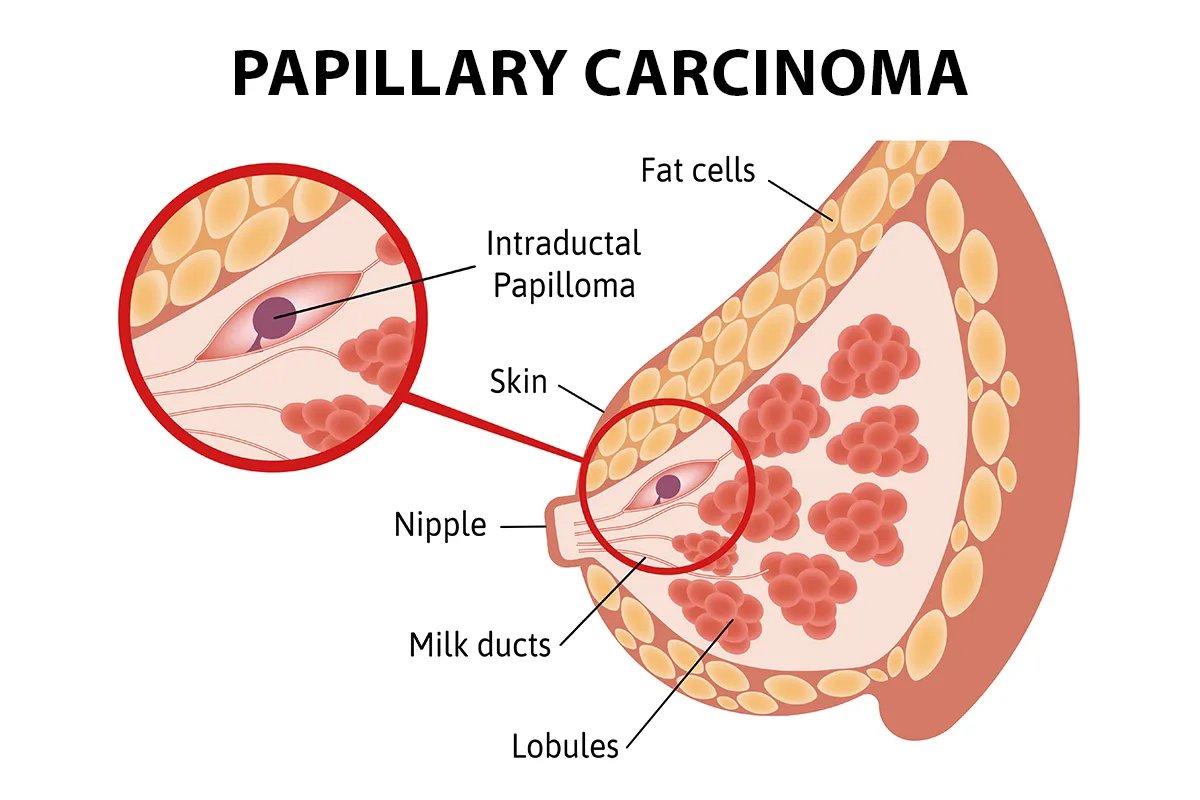Papillary carcinoma
Encuentre un especialista en cáncerThere are many forms of breast cancer. One form is papillary carcinoma, which is characterized by its unique finger-like growths within the breast milk ducts.
At Aurora Health Care, we're dedicated to providing comprehensive information and personalized care to help you navigate your diagnosis with confidence and clarity. We offer the latest cancer care technology, including genetic counseling to better determine your risk and a range of diagnostic tools to accurately diagnose papillary carcinoma breast cancer.
What is a papillary carcinoma?

Papillary carcinoma breast cancer starts in the milk ducts. It’s a rare and unique form that is characterized by finger-like projections. It can occur in one or both breasts and is often discovered during routine mammograms or when you notice changes in your breast tissue in a self-exam.
Papillary carcinoma breast cancer can appear in two forms: invasive and in situ. Invasive papillary carcinoma spreads beyond the ducts, while in situ remains confined.
This form of breast cancer is more common in postmenopausal women and can be benign (noncancerous) or malignant (cancer).
Types of papillary carcinoma
- Encapsulated papillary carcinoma: Typically confined within a thick fibrous capsule in the breast ducts and is less likely to spread.
- Solid papillary carcinoma: Forms solid masses in the breast ducts and can be either benign or malignant.
- Invasive papillary carcinoma: Starts in the breast ducts and spreads to surrounding tissues.
Is papillary breast cancer aggressive?
Generally, papillary breast cancer is considered less aggressive compared to other types of breast cancer. However, invasive papillary carcinoma has the potential to spread beyond the original site, so it’s considered more aggressive. It's also crucial to diagnose whether the papillary carcinoma is invasive or in situ to understand the potential aggressiveness of the disease.
Risk factors for papillary carcinoma
- Edad: Most common in postmenopausal women between the ages of 45 and 55.
- Antecedentes familiares: A family history of breast cancer can elevate your risk.
- Mutaciones genéticas: Certain genetic factors such as BRCA1 and BRCA2 gene mutations that are passed down from a parent can increase your risk.
- Factores hormonales: Hormone replacement therapy post-menopause can increase your risk.
Recognizing these risk factors can help in early detection and prevention strategies.
Papillary carcinoma symptoms
Symptoms of papillary carcinoma can be subtle and vary for every person. Common signs to watch for include:
- Breast lumps: Noticeable lumps that feel different from the surrounding tissue.
- Secreción del pezón: Unusual discharge, which may be clear or bloody.
- Breast changes: Alterations in the size, shape or appearance of the breast.
- Cambios en la piel: Dimpling or changes in skin texture over the breast.
Los autoexámenes y mamografías periódicos son fundamentales para la detección temprana.
Papillary carcinoma diagnosis
Diagnosing papillary carcinoma breast cancer usually involves a combination of imaging tests and biopsies.
Una mamografía suele ser el primer paso, ya que puede revelar bultos o anomalías en el tejido mamario. Si una mamografía indica una anomalía, una ecografía proporciona una imagen más clara, lo que ayuda a determinar si el bulto es sólido o está lleno de líquido.
To confirm papillary carcinoma, your doctor will perform a biopsy. Esto implica tomar una pequeña muestra de tejido del bulto para examinarla bajo el microscopio. Types of biopsies include core needle biopsy and excisional biopsy, depending on the carcinoma’s characteristics.
Once a diagnosis is confirmed, your provider will discuss the appropriate treatment options with you.
Papillary carcinoma treatment
Treatment options for papillary carcinoma vary based on the type and stage of your cancer. Common treatments include:
- Cirugía: Lumpectomy or mastectomy to remove cancerous tissue.
- Radioterapia: Targets and kills cancer cells remaining post-surgery.
- Terapia hormonal: For hormone receptor-positive cancers, to slow or stop cancer growth.
- Quimioterapia: Uses drugs to destroy cancer cells, typically for invasive types.
At Aurora, your care team will use a collaborative approach to deliver the best treatment for you. También ofrecemos diversos servicios de apoyo, que incluyen asesoramiento, terapia nutricional, cuidados paliativos y fisioterapia.
What is the prognosis of papillary carcinoma?
The prognosis for papillary carcinoma is generally favorable, especially when detected early. In situ types have a better prognosis with appropriate treatment.
Invasive papillary carcinoma can also have a good outcome with timely and effective treatment. Regular follow-ups and monitoring are essential to manage and detect any cancer recurrence early.
¿Tiene riesgo de padecer cáncer de seno?
Conocer sus probabilidades de desarrollar cáncer de mama puede ayudarla a planificar un cronograma de pruebas de detección de rutina. Nuestro cuestionario de salud de los senos calcula sus riesgos a cinco años y de por vida, y le da una idea de qué hacer a continuación en función de sus resultados.
Reciba atención
We help you live well. And we're here for you in person and online.